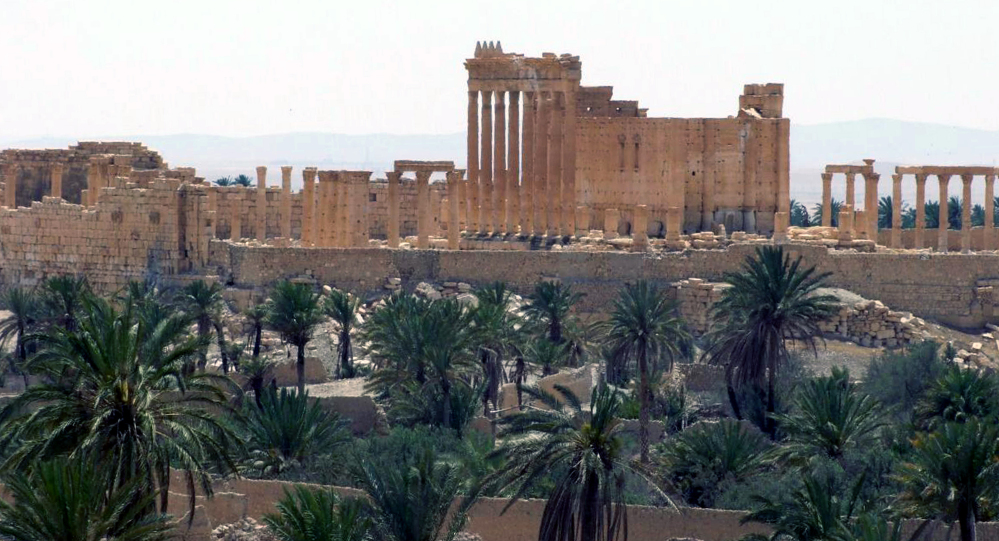DAMASCUS, Syria — Islamic State extremists in Syria and Iraq are engaged in the “most brutal, systematic” destruction of ancient sites since World War II, the head of the U.N. cultural agency said Friday – a stark warning that came hours after militants demolished a 1,500-year-old monastery in central Syria.
The world’s only recourse is to try to prevent the sale of looted artifacts, thus cutting off a lucrative stream of income for the militants, UNESCO chief Irina Bokova told The Associated Press.
A series of recent attacks has stoked fears that IS is accelerating its campaign to demolish and loot heritage sites. On Friday, witnesses said the militants bulldozed St. Elian Monastery in central Syria.
Days earlier, IS beheaded an 81-year-old antiquities scholar who had dedicated his life to overseeing the ruins of Palmyra in Syria, one of the Middle East’s most spectacular archaeological sites.
Since capturing about a third of Syria and Iraq last year, IS fighters have destroyed mosques, churches and archaeological sites, causing extensive damage to the ancient cities of Nimrud, Hatra and Dura Europos in Iraq. In May, they seized Palmyra, the Roman-era city on the edge of a modern town of the same name.
“We haven’t seen something similar since the Second World War,” Bokova said of the scope of the IS campaign against ancient sites. “I think this is the biggest attempt, the most brutal systematic destruction of world heritage.”
Bokova said recent images of archaeological sites under IS control in Iraq and Syria show signs of widespread illegal digging and looting.
There is very little the world can do to stop the extremists from inflicting more damage, she said, but stopping the trafficking in artifacts must be a priority.
Bokova spoke hours after IS posted photos on social media showing bulldozers destroying the St. Elian Monastery near the town of Qaryatain in central Syria. The group had captured the town in early August.
A Qaryatain resident who recently fled to Damascus said militants leveled the shrine and removed church bells. The man, who spoke on condition of anonymity for fear his relatives might be harmed, called on the United Nations to protect Christians and Christian sites.
Osama Edward, the director of the Christian Assyrian Human Rights Network, said shelling of the area by Syrian government troops over the past two weeks had already damaged the monastery. “Daesh continued the destruction of the monastery,” said Edward, using an Arabic acronym for the Islamic State group.
A Catholic priest, the Rev. Jacques Mourad, who had lived at the monastery, was kidnapped in May and remains missing. According to Edward, Mourad sheltered both Muslim and Christian Syrians fleeing the fighting elsewhere in Homs province.
In another attack, IS militants beheaded Palmyra scholar Khaled al-Asaad on Tuesday, hanging his bloodied body from a pole in the town’s main square.
Bokova said she believes al-Asaad was “brutally murdered” because he refused to divulge where authorities had hidden treasures secreted out of Palmyra before the IS takeover. She would not say whether UNESCO was aware of where the artifacts were taken, saying only “we hope they are in safe places.”
Palmyra has remained largely intact, but Bokova said “we know that some of the destruction is starting.”
Archaeological sites in northern Iraq have also been hard-hit. The destruction there, including smashing ancient statues with a sledgehammer, is a “huge tragedy for all of humanity,” Bokova said.
She said the international community is stepping up efforts to halt the trade in looted antiquities from Syria and Iraq.
Send questions/comments to the editors.



Success. Please wait for the page to reload. If the page does not reload within 5 seconds, please refresh the page.
Enter your email and password to access comments.
Hi, to comment on stories you must . This profile is in addition to your subscription and website login.
Already have a commenting profile? .
Invalid username/password.
Please check your email to confirm and complete your registration.
Only subscribers are eligible to post comments. Please subscribe or login first for digital access. Here’s why.
Use the form below to reset your password. When you've submitted your account email, we will send an email with a reset code.